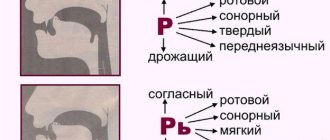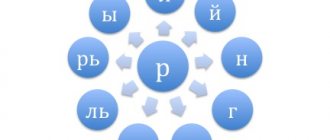Dyslalia occurs:
- Phonetic - distortion of pronunciation (When a child says various sounds incorrectly - R, L and others).
- Phonemic - replacement of sounds (Replacement of letters, for example S - Sh: went-ambassador).
- Phonetic-phonemic – articulatory disorders.
There are simple and complex dyslalia. Simple implies disorders associated with the perception of one sound or one phonetic group. Complex – when sounds from different phonetic groups are not perceived. Phonetic groups are sonorants (P, Rb, L, L, N, N', M, M', J), whistling (S, S', Z, Z'), sibilants (Zh, Sh), africates (Ch, Shch).
Simple dyslalia has forms that include various types of disorders:
- Sigmatism
- Parasigmatism
- Rotacism
- Pararotacism
- Lambdacism
- Yotacism
- Gamacism
- Kappacism
- Hitism
Features of sigmatism
- The defect in speech is built symmetrically, that is, if a hard sound suffers, then the soft one is also distorted.
- If only soft sibilants are used, then the sibilants will be pronounced softer.
- Nasal sigmatism is also determined, but it does not exist as such. If there is a nasal pronunciation of whistling and hissing sounds, then the pronunciation of all sounds will be nasal, and this is rhinolalia. However, nasal sigmatism can occur in deaf and mute people when sounds are presented to them.
- Hissing and whistling sounds are sharply contrasted in terms of acoustic characteristics, but less contrasting in terms of articulation.
Correction
Health care
Special treatment is required to eliminate factors predisposing to sigmatism. Bite correction may include various types of orthodontic care: wearing braces, special mouth guards, and devices of various types. If necessary, orthognathic intervention is performed. The choice in favor of surgical tactics for a shortened frenulum is made if it is impossible to stretch the ligament using speech therapy methods.
In case of disturbances in the innervation of the articulatory muscles, all speech therapy work is carried out against the background of drug treatment and physiotherapy prescribed by a neurologist. The lack of free nasal breathing, as a cause of sigmatism, requires appropriate treatment: removal of the adenoids, antiallergic therapy.
Speech therapy correction
Speech therapy work to eliminate all forms of sigmatism is subject to a single algorithm. It includes three periods during which certain corrective tasks are solved:
- Preparatory.
At this stage, the necessary articulation patterns are formed: the correct position of the lips and tongue. Work is underway to develop the strength and direction of the air stream. Support sounds are practiced ([I], [F] - for [S], [T], [S] - for [Sh]. Methods by which the objectives are achieved include articulation and breathing exercises, and, if indicated, speech therapy massage . - Sound production.
It is carried out in different ways: by imitation (“how a pump whistles”, “like a mosquito rings”, “like a snake hisses”), using articulation exercises or with the help of instruments (probe substitutes, probes). The basic sound for all whistling sounds is [S], and for other hissing sounds - [Ш]. - Automation.
Having achieved the correct pronunciation of an isolated sound, they move on to consolidating it, sequentially introducing syllables (direct, reverse, with a combination of consonants), words, phrases and spontaneous speech. After practicing hard sounds, they begin to assimilate their soft pairs. There is no differentiation stage for sigmatism and other sound distortions.
The traditional sequence of production of sounds is determined by the timing of their appearance in ontogenesis. If both groups are violated, the sound production of whistling sounds is carried out first, then hissing sounds (an exception may be dysarthria, when the sounds are placed in the reverse order).
If sigmatism is part of a complex speech defect, then work is carried out in parallel on other aspects of speech: syllable structure, vocabulary, grammar, prosody, etc. The time frame for correcting sigmatism may vary for different children; the period of speech therapy work takes up to 45-90 days or more.
Rotacism
This is a violation of the pronunciation of the sounds “R” and “R”. Rhotacism is very common due to the articulatory difficulty of pronunciation. Babies have a regular "R" sound in their babble. But children begin to pronounce a real, pure “R” after 2 years. Articulatory preparedness plays a role here. Normally, the respiratory stream flows through the center of the tongue, the tip of which vibrates, the side edges are pressed against the upper outer teeth.
In case of deviation from the norm, the following are distinguished:
- Lateral rhotacism - one edge of the tongue does not adhere to the upper molars. There is a squelching shade - an average between "r" and "l"
- Guttural rotacism - the activity of the root of the tongue is impaired
- Velar rhotacism - vibration occurs when the root of the tongue approaches the boundaries of the hard and soft palate
- Uvular rotacism - the small tongue of the uvulus vibrates.
- Rolling – forced use of the tongue
- Single-stroke or fricative - pronouncing the English sound “r”
- Kucherskoe “r” is a back-lingual sound like the English “r”.
Yotacism
Replacing the letter "y" with "l". There are three defects in the pronunciation of back-lingual sounds:
- Gamacism - sound "g"
- Kappacism - the sound "k"
- Hitism (x) - replacing the sounds “x” with “f”, especially before “v”. Or "хх" on "х". For example, cunning - cunning.
Gamacism and cappacism are usually found together in practice. They are characterized by:
- The absence of the sounds “G” and “K”.
- Replacing “k” and “g” with “t” and “d”. For example, a rabbit is a troll.
- Replacing "k" with "k".
All these defects arise due to certain systems of activity. Most sounds are front-lingual and these sounds are also pronounced as front-lingual.
Complex dyslalia
Complex dyslalia includes cases in which combinations of various defects are observed. The most common of them:
- Rotacism and lambdacism
- Rotacism and sigmatism
In cases of a shortened hyoid frenulum, a posterior lingual sound “r” or a replacement of “r” with “d” and lower softened sibilants are observed. For example, the frame is a queen.
- Rotacism, lambdacism and sigmatism
- Phonetic-phonemic disorders
- A combination of phonetic and phonemic, that is, some sounds are replaced, others are distorted.
- The defect is associated with the contrast of sounds in terms of hardness-softness, ringing-dullness with one or another type of defect in the pronunciation of one sound (sigmatism, rhotacism).
- Total dyslalia - when in the child’s pronunciation, of all consonant sounds, only “t” and “d” and nasal, sonorant sounds remain, and vowels are in order. For example: sam-dam, hat-slipper and others.
Sometimes only one sound “t” remains - this defect is called Hottentatism (from the African tribe “Hottentot” - in their speech there are only two consonants - “t” and “d”).
Prevention of rotacism with a short hypoglossal ligament
The hyoid frenulum looks like a thin membrane that connects the sublingual area of the mouth with the tongue. With a normal structure, it is attached to the middle of the inner surface of the tongue, its length is about 8 mm.
To check the length of the child's frenulum, you need to ask him to touch the roof of his mouth with his tongue with his mouth wide open: a problem-free manipulation indicates a normal frenulum length. If, while performing the action, the child was unable to reach the sky or experiences discomfort, it is imperative to consult a speech therapist. If the frenulum is located too close to the tip of the tongue, it needs correction. It is performed to avoid speech problems, including the occurrence of rhoticism.
If the frenulum was not cut in infancy, it is trimmed during the preschool period. Pruning for preschoolers is done under local anesthesia. The frenulum is cut and self-absorbing sutures are applied. The latest technologies allow this operation to be performed using a laser. The laser method minimizes pain, reduces swelling after surgery, and eliminates the need for stitches. Postoperative rehabilitation includes a special diet and exercises to develop the frenulum.
An alternative way to correct a shortened hyoid ligament is articulation gymnastics. This is no less effective, and at the same time painless method. The essence is to perform speech therapy exercises for the language.
They usually tire the child very much and often provoke discomfort. Because of this drawback, they should be performed under the supervision of a speech therapist, gradually increasing the load. Non-surgical stretching of a shortened frenulum requires a long period of time.
Features of complex dyslalia
The more complex the combination of dyslalia, the more complex the background against which it occurs: a delay in general and mental development. In cases of complex dyslalia, an in-depth additional study of the child is necessary, not only in terms of the characteristics of his behavior, but also intellectual capabilities, as well as characteristics of hearing and vision. Complex dyslalia is a signal that something is wrong with the child’s hearing or vision. In children with hearing impairments, very often the front-lingual sounds are either sharply distorted or replaced by the sound “t”.
If a child has hearing loss of the 2nd or 3rd degree, then an auxiliary criterion will be the peculiarity of the voice; it lacks the necessary metal, the voice seems to be “cotton-like.”
Children with severely reduced vision and blind children may also experience pronunciation defects such as complex dyslalia. This is due to the fact that in such children, sigmatism occurs 3-4 times more often than in the norm. This is due to visual control. But if we establish a connection between interdental sigmatism and visual defects, then, consequently, all hearing-impaired people should have interdental sigmatism, but this is not the case. After all, the child does not see the sounds “k”, “g”, “n” - they are not impaired, but they have complex dyslalia.
A visual defect interferes with speech in general - the blind do not speak by imitation, the visually impaired cannot ask anything, they are passive. Initiative speech develops by age 4. The pronunciation system is formed when the teeth begin to change, hence interdental sigmatism appears. Complex dyslalia occurs against the background of delayed speech communication due to visual defects.
With hearing defects, disorders of the maxillomuscular system are often encountered: progenia, prognathism, anterior open bite, lateral open bite.
First of all, it should be noted that to denote distorted pronunciation of sounds, international terms are used, derived from the names of the letters of the Greek alphabet using the suffix “-ism”. They are distinguished: sigmatism, rotacism, lambdacism, iotacism, gammacism, hitism. In cases where a replacement of sound is noted, the prefix “-para” is added to the name of the defect - parasigmatism, pararotacism, etc. (L.S. Volkova, S.N. Shakhovskaya, 2002, p. 97).
Sigmatismus, a speech disorder involving incorrect pronunciation of hissing and whistling sounds. In children suffering from sigmatism, there is a violation of the pronunciation of sounds [s], [z], [ts] and [sh], [zh], [h], [sch]. Sigmatism is one of the very common types of incorrect sound pronunciation. There is a fairly large number of variants of both purely phonetic sigmatism (interdental, lateral, nasal, labiodental) and parasigmatism (dental, whistling, hissing). This suggests that the pronunciation of whistling and hissing sounds is quite difficult.
Various defects in the pronunciation of the sound [r] are combined under the name rhotacism. Due to the great complexity of articulatory work, and in particular the tongue (all muscles of the tongue are involved), many types of rotacism are observed. For example, speech therapist A.Ya. Jaunberzin registered 28 variants. The most common will be the following: absence of [r] (complete absence of sound or the sound of a vowel instead), nasal pronunciation, throat pronunciation (velar or uvular), single-stress, voiceless, bilabial [r]. There are many options and pararotacism: replacements - r-d, r-y, r-l, r-l, r-n, r-g, r-s.
All defects in the pronunciation of the sound [l] are combined under the name lambdacism. There are three types of lambdacism: absence of sound [l] or oversound of a vowel, bilabial or labial-dental pronunciation of the sound [l], nasal pronunciation - l-ng; paralambdacisms: l-d, l-l' (with varying degrees of softening), l-r, l-v, l-n, l-s or u.
Defects in the pronunciation of the semivowel sound [th] are called iotacism. The sound [й] is used in Russian in two meanings: as a non-syllabic sound (edge, tea, war) and as a syllabic sound included in the pronunciation of iotated vowels i, e, yu, e at the beginning of a syllable. These two meanings of the sound [th] receive slightly different expressions due to defects in the pronunciation of the sound. Pronunciation defects: 1) the sound [th] is not pronounced at all (moy-mo; yama-ama); 2) [th] is replaced by [i] (my - mine; yama - iama); 3) [th] is replaced by [l] (chai-chal; yama.-lyamo).
Defects in the pronunciation of palatal sounds are called kappacism - sounds k and k', gammacism - sounds g and g', hitism - sounds x and x' (R.E. Levina, 1968).
In addition to those described above, speech therapy literature identifies disorders in the softening and voicing of sounds.
In the pronunciation of consonants that have a voiced and a voiceless pair, voicing defects are observed. Three types of voicing disorders are observed: a) complete absence of voiced consonant sounds in speech, i.e. their constant replacement with paired deaf ones; b) insufficient voicing; c) insufficient stunning. All three cases relate to paralalia and, as a rule, are reflected in writing. Researchers note that devoicing of voiced consonants is observed more often than voicing of deaf consonants.
Among softening defects, three options are also observed: a) complete absence of soft consonant sounds in speech, i.e. their constant replacement with paired hard sounds; b) excessive softening c) violation of differentiation between hard and soft sounds, i.e. Along with the correct pronunciation of hard and soft consonants, deviations are observed in both directions.
Having examined the speech therapy classification of sound pronunciation disorders, it must also be said that in different children, incorrect pronunciation can either concern only one group of sounds (voiced, velar or sibilant, etc.), and then it is called a simple, partial, monomorphic sound pronunciation defect, or cover many groups of sounds (at the same time the same child can suffer from rhotacism, sigmatism and voicing defects, etc.), then the defect is called complex diffuse, polymorphic (L.S. Volkova, S.N. Shakhovskaya, 2002).
Naturally, the more complex the indicated defect, the more the euphony and intelligibility of speech suffers. The more complex the sound, the later and more difficult it is for the child to establish its correct pronunciation and the more diverse the pronunciation defects will be.
Many authors note that in some cases children correctly use sound in isolation, in syllables, and sometimes in words and in reflected speech, but do not use it in independent speech (L.S. Volkova, S.N. Shakhovskaya, 2002, p.97 ). Similar phenomena are noted in the works of O.V. Pravdina (1973), K.P. Beckera, M. Sovaka (1981), M.E. Khvattseva (1996), etc. These data indicate that children’s pronunciation skills correlate with the degree of complexity of the type of speech activity.
O.V. Pravdina (1973) distinguishes three levels of impaired pronunciation: inability to correctly pronounce a sound or group of sounds; incorrect pronunciation of them in speech when correctly pronounced in isolation or in light words; insufficient differentiation (mixing) of two sounds that are similar in sound or articulation with the ability to correctly pronounce both sounds. The identified levels reflect the stages of sound acquisition in the process of child development, identified by A.N. Gvozdev (1961). These data indicate that a child with impaired pronunciation goes through the same stages of sound acquisition as a normal child, but at some stage he may be delayed or stop.
As T.B. points out. Filicheva, N.A. Cheveleva, G.V. Chirkina (1989), in the process of normal development of a child’s auditory function, a number of stages can be distinguished: a) in the first hours after birth, the child has a simple reaction to sound (like unconditioned reflexes), when in response to a loud knock, blow, noises occur changes in sucking movements, pulsation, breathing; b) at the 3rd month. the child develops the ability to distinguish sounds by pitch and timbre; c) at 10 - 11 months. the ability to distinguish words and phrases by their intonation and rhythmic coloring is formed; d) during the period of further speech formation, thanks to the gradual improvement of auditory function, the perception of the sound composition of speech improves, and the ability to distinguish by ear all phonemes of the native language is formed. This is one of the necessary conditions for the successful development of children's speech.
At the same time, R.M. Boskis (1988, p. 30) writes: “The auditory analyzer, unlike other analyzers, plays a decisive role in the development and functioning of auditory speech. Therefore, the most characteristic specific deviations in the development of a child with a defect in the auditory analyzer are associated with the characteristics of his speech development.” The author points out that it is also important to keep in mind that hearing and speech are very closely related. Not only hearing damage leads to deviations in the development of auditory speech, but also the functioning of the auditory analyzer is closely dependent on the level of speech development. The richer the speech, the easier it is to use an inferior auditory analyzer to perceive it.
T.B. Filicheva, N.A. Cheveleva, G.V. Chirkina (1989, p. 167) note that characteristic deficiencies in pronunciation in children with hearing impairment are the following: a) confusion of sounds, often voiced with deaf, hissing with whistling, hard with soft; b) there is often a replacement of some sounds with others, for example, whistling sounds with plosives, etc.; c) softening defects (“auntie” instead of grandfather, “tota” instead of auntie); voicing defects; d) the absence of one of the component sounds due to the late formation of affricates; e) distorted pronunciation of sounds. Along with this, hearing-impaired children do not master the pronunciation of sounds that are difficult to articulate (r, l, ch, sch, ts, etc.). According to these authors, the speech of the hearing impaired is characterized by general blurriness and poor intonation. The voice of such children is dull and poorly modulated. The pace of speech is usually slow.
As L.S. writes Volkova and S.N. Shakhovskaya (2002, p. 491), “auditory differentiation of speech sounds in the hearing impaired suffers primarily due to the limitation of the range of sound frequencies perceived by them. In addition, in children there is a secondary underdevelopment of analytical-synthetic activity in the central section of the speech-auditory analyzer, caused by the “poor quality” of auditory stimuli coming from the periphery (complete impossibility of perceiving sounds by ear or not perceiving all their formants).”
L.V. Neiman and V.I. Beltyukov (1958, p. 84) note that children with degree I hearing loss can distinguish no more than 75% of consonants pronounced in a voice of conversational volume near the auricle itself. At the same time, already at a distance of 0.5 m from the ear, the ability to distinguish consonants is reduced to 60%, and at a distance of 2 m - even to 40%. The perception of coherent speech under these conditions is possible only because children who are fully proficient in speech rely on their existing holistic images of words and phrases, which allows them to infer (often erroneously) the missing links. If the child does not speak detailed speech, then such speculation turns out to be impossible. Therefore, children with the same degree of hearing loss, but with different levels of speech development, recognize speech sounds differently. For this reason, even with the same degree of hearing loss, the state of auditory differentiation of speech sounds in students of the second department of the school for the hearing impaired is generally much worse than in students of the first department.
However, even in the first department of the school for the hearing impaired, according to research by L.G. Paramonova (1981), over 78% of high school students do not differentiate by ear from 4 to 45 pairs of consonant sounds. The auditory differentiation of sibilants s and c in words like light - color is especially difficult. According to the study by L.V. Neumann (1961, p. 239), for hearing-impaired students of the first department, the perception of whistling and hissing sounds also poses a difficulty. In addition to the purely acoustic features mentioned, it is also reflected in the fact that these sounds begin to differentiate in pronunciation relatively late. Here we observe the inhibitory influence of the speech motor analyzer on the auditory speech analyzer. Auditory differentiation of other phonetic groups of consonant sounds for hearing-impaired students of the first department presents significantly less difficulties.
L.V. Neumann (1961) and L.G. Paramonova (1981) also provide data on impaired sound pronunciation in hearing-impaired schoolchildren. They note that sound pronunciation is especially impaired in hard-of-hearing students of Division II, not only of consonants, but even of vowels. However, in the first department of schools for the hearing impaired, there are sound pronunciation defects even in high school. As with the hard-of-hearing group II, cases of polymorphic disturbances in sound pronunciation prevail here, covering many phonetic groups of sounds (on average, there are 11 defectively pronounced sounds for each student). Even the hearing impaired in the first department suffers from the pronunciation of not only articulatory complex consonants, but also relatively articulatory simple consonants (labial, labiodental, anterior lingual, etc., d, n, etc.). The basis of their disorders is the inferiority of the work of not only the speech-auditory, but also the speech-motor analyzer.
That is, as can be seen, all authors indicate that the formation of sound pronunciation in the hearing impaired proceeds with significant deviations from the norm due to the inferiority of the speech-auditory analyzer, which is not able to carry out its “leading role” to the required extent in relation to the speech-motor analyzer. Unable to perceive a particular speech sound by ear or differentiate it from similar sounds, the child cannot independently master its correct articulation. Children who are hard of hearing may have disturbances in the structure and functioning of the speech motor analyzer, which may also cause them to have defective pronunciation of sounds.
The state of auditory differentiation of speech sounds in the hearing impaired of the first department is such that it cannot ensure that children master full sound pronunciation, and subsequently, writing.
Thus, we can distinguish three main forms of sound pronunciation impairment in hearing-impaired schoolchildren.
1. In case of insufficiency of the sensory part of the speech apparatus, i.e. defective activity of the auditory analyzer, characterized by the replacement of some speech sounds with others (“suba” instead of shuba). Less often than replacements, distorted pronunciation of sounds is observed, associated with the impossibility of their clear auditory differentiation from other sounds or with the complete impossibility of perceiving them by ear due to the partial loss of the corresponding sound frequencies. Deviations from the norm in the structure or functioning of the motor part of the speech apparatus are usually not observed in sensory forms of sound pronunciation impairment. Sound substitutions present in a child’s oral speech are usually reflected in writing in the form of corresponding letter substitutions. In lower grades of hearing-impaired schools, such forms of sound pronunciation disorders usually come to the fore.
2. Due to insufficiency of the motor part of the speech apparatus, i.e. deviations from the norm in the structure or functioning of the articulatory organs, violations are usually expressed in the distorted sound of sounds (burry r, interdental or lateral s, etc.).
3. Mixed forms of sound pronunciation disorders, caused simultaneously by both sensory and motor insufficiency. In these cases, in the same child, defects in the pronunciation of some sounds are associated with the impossibility of their auditory differentiation from similar phonemes (replacement of c with s), while defects in the pronunciation of other sounds are associated with deviations from the norm in the structure or functioning of the articulatory apparatus (for example, burry r with a short hypoglossal ligament or interdental with paretic muscles of the tip of the tongue). Sometimes defects in the pronunciation of the same sounds in a child have both motor and sensory causes. This occurs in cases where the inability to perform the articulatory movements necessary to pronounce a given sound is combined with the impossibility of auditory differentiation from sounds that are acoustically close to it (L.S. Volkova, S.N. Shakhovskaya, 2002).
At the same time, L.G. Paramonova (1981, p.6) writes that “in hearing-impaired children, mixed forms of sound pronunciation disorders are predominant.”
It should also be noted that the child’s capabilities in preserving auditory representations of speech and the features of this process in conditions of hearing impairment can be examined based on the material of his writing, which reflects his auditory-speech representations. L.V. Korshunova (1972) gives a number of typical violations of the phonetic composition of words found in the writing of hearing-impaired children: 1) expressed in the replacement of a voiced consonant with a deaf one (more - poland, books - books); in the replacement of deaf - voiced (boots - sabogs); 2) expressed in various kinds of replacements of a soft consonant with a hard one and a hard consonant with a soft one (airplanes - airplanes, fork - vylka, again - honey mushrooms, pencil case - pencil case); 3) violations of the sound composition of words, including hissing and affricates (brush - shetka, matches - spishki, prey - prey, hare - hare); 4) violation in the writing of words that contain compounds of the vowel sound “and” (bunnies - zachiki, leika - leika, hedgehog - ezh, dress - pay); 5) various disorders, expressed in complete or partial distortion of the sound composition of the word and violation of the syllabic structure (today - sevoli, healthy - zarov, catch - ovut, remove - upira).
The reason that makes it difficult for a late-deaf child to learn to write and causes these disturbances is L.V. Korshunova considers the special conditions for the activity of the auditory analyzer. Auditory representations of words are not supported by actual auditory perceptions. This circumstance leads to a change in the characteristics of auditory representations of speech and determines the uniqueness of analytical activity in the writing process.
Thus, proper hearing is crucial for the development of a child’s speech. And the quality of the phonetic design of the speech of a hearing-impaired child, as noted by F.F. Rau (1981), it depends to what extent it is understandable to others and to what extent it can serve as a basis for language proficiency and serve as a tool of thinking. For the purposes of communication with others, it is important that the speech of a child with hearing loss is phonetically intelligible. But for the true development of oral speech, and in particular its phonetic-phonemic side, a hearing impaired person needs special training. Practice has long proven that as a result of training, children with hearing impairment are able to master verbal speech not only in a more accessible written and dactylic form, but also in the form of the spoken word. References: 1) Becker K.P., Sovak M. Speech therapy. - M.: Medicine, 1981. - 288 p. 2) Beltyukov V.I., Neiman L.V. Perception of speech sounds in normal and impaired hearing. - M.: APN RSFSR, 1958. - 51 p. 3) Boskis PM To the teacher about children with hearing impairments. - M.: Education, 1988. - P.26-48. 4) Gvozdev A.N. Issues in studying children's speech. - M.: APN RSFSR, 1961. - 131 p. 5) Korshunova L.V. Writing impairment in late-deafened children. // Defectology. No. 4. 1972. - P.41-45. 6) Speech therapy. 3rd ed., revised. and additional / Edited by Volkova L.S., Shakhovskaya S.N. - M.: Vlados, 2002. - 680 p. 7) Neiman L.V. Hearing function in hard of hearing and deaf-mute children. - M. Publishing house of the Academy of Pedagogical Sciences of the RSFSR, 1961. - 359 p. Fundamentals of the theory and practice of speech therapy. / Ed. R.E. Levina. - M.: Education, 1968. - 367 p. 9) Paramonova L.G. Guidelines for identifying and correcting defects in sound pronunciation and related writing disorders in hearing-impaired students of the first department. — L.: Len. Department of Science, 1981. - P.6-10. 10) Pravdina O.V. Speech therapy. Textbook manual for defectologist students. fact-tov ped. Inst. Ed. 2nd, add. and processed - M.: Education, 1973. - 272 p. 11) Rau F.F. Formation of oral speech in deaf children. / Ed. and with a preface. T.A. Vlasova and others - M.: Pedagogika, 1981. - 168 p. 12) Filicheva T.B., Cheveleva N.A., Chirkina G.V. Basics of speech therapy: Textbook. - M.: Education, 1989. - P.165-172. 13) Khvattsev M.E. Speech therapy. - M.: Aquarium, St. Petersburg: Delta, 1996. - 384 p.
And the quality of the phonetic design of the speech of a hearing-impaired child, as noted by F.F. Rau (1981), it depends to what extent it is understandable to others and to what extent it can serve as a basis for language proficiency and serve as a tool of thinking. For the purposes of communication with others, it is important that the speech of a child with hearing loss is phonetically intelligible. But for the true development of oral speech, and in particular its phonetic-phonemic side, a hearing impaired person needs special training. Practice has long proven that as a result of training, children with hearing impairment are able to master verbal speech not only in a more accessible written and dactylic form, but also in the form of the spoken word. References: 1) Becker K.P., Sovak M. Speech therapy. - M.: Medicine, 1981. - 288 p. 2) Beltyukov V.I., Neiman L.V. Perception of speech sounds in normal and impaired hearing. - M.: APN RSFSR, 1958. - 51 p. 3) Boskis PM To the teacher about children with hearing impairments. - M.: Education, 1988. - P.26-48. 4) Gvozdev A.N. Issues in studying children's speech. - M.: APN RSFSR, 1961. - 131 p. 5) Korshunova L.V. Writing impairment in late-deafened children. // Defectology. No. 4. 1972. - P.41-45. 6) Speech therapy. 3rd ed., revised. and additional / Edited by Volkova L.S., Shakhovskaya S.N. - M.: Vlados, 2002. - 680 p. 7) Neiman L.V. Hearing function in hard of hearing and deaf-mute children. - M. Publishing house of the Academy of Pedagogical Sciences of the RSFSR, 1961. - 359 p. Fundamentals of the theory and practice of speech therapy. / Ed. R.E. Levina. - M.: Education, 1968. - 367 p. 9) Paramonova L.G. Guidelines for identifying and correcting defects in sound pronunciation and related writing disorders in hearing-impaired students of the first department. — L.: Len. Department of Science, 1981. - P.6-10. 10) Pravdina O.V. Speech therapy. Textbook manual for defectologist students. fact-tov ped. Inst. Ed. 2nd, add. and processed - M.: Education, 1973. - 272 p. 11) Rau F.F. Formation of oral speech in deaf children. / Ed. and with a preface. T.A. Vlasova and others - M.: Pedagogika, 1981. - 168 p. 12) Filicheva T.B., Cheveleva N.A., Chirkina G.V. Basics of speech therapy: Textbook. - M.: Education, 1989. - P.165-172. 13) Khvattsev M.E. Speech therapy. - M.: Aquarium, St. Petersburg: Delta, 1996. - 384 p.
Methods for eliminating dyslalia
- Work to overcome dyslalia is always associated with the formation of new skills and abilities, that is, a speech therapist-defectologist rebuilds the child’s existing pronunciation system. Read more about when a child needs a speech therapist.
- Classes to overcome dyslalia have a developmental role: speech therapy is aimed at developing skills and abilities. This work is educational, and the learning process, unlike the process of imitation, is a conscious process.
- The guideline in speech therapy work is the pronunciation norms adopted in the Russian language. Read more about establishing the correct pronunciation of the sounds R and L.
- All work on correcting pronunciation is pedagogical. In cases of medical influence, only a favorable background is created, but it does not correct the defect. Training, demonstrations (when a speech therapist shows the correct articulation of various words in the mirror), etc. are used as pedagogical paths.
- During the classes, the psychophysiological mechanism that ensures normal pronunciation is worked out, as well as the motor-articulatory, auditory and speech-motor system so that the child is capable of normal pronunciation.
Date of publication: 02/04/2016. Last modified: 05/05/2021.
Treatment of lambdacism at the multidisciplinary center “Academy of the XXI Century. Speech.Intelligence”
When faced with such a problem as lambdacism, there is no need to be ashamed of it, much less let it take its course. Modern treatment methods, qualified specialists, an individual approach to each client and a comprehensive examination of the multidisciplinary center “Academy of the XXI Century. Speech.Intellect” will help to cope with this task. Our main specialist and project manager, Danilkina Margarita Yurievna, is a hereditary defectologist, a famous speech therapist, neuropsychologist, oligophrenopedagogue, specialist in the development of intelligence, rehabilitation, diagnosis and correction of developmental disorders in children and adults, the author of unique methods for the development of children in conditions of sensory-emotional play expansion and advanced development, professor, full member of the European Academy of Natural Sciences (Hannover).
There are no unsolvable problems, there are just lazy specialists. Professor Danilkina Margarita Yurievna has many scientific works on very complex diagnoses. Giving lectures at various universities around the world and conducting practical work. New techniques allow you to achieve amazing results.
Contact us at the center and you will see that together we can handle mountains.









